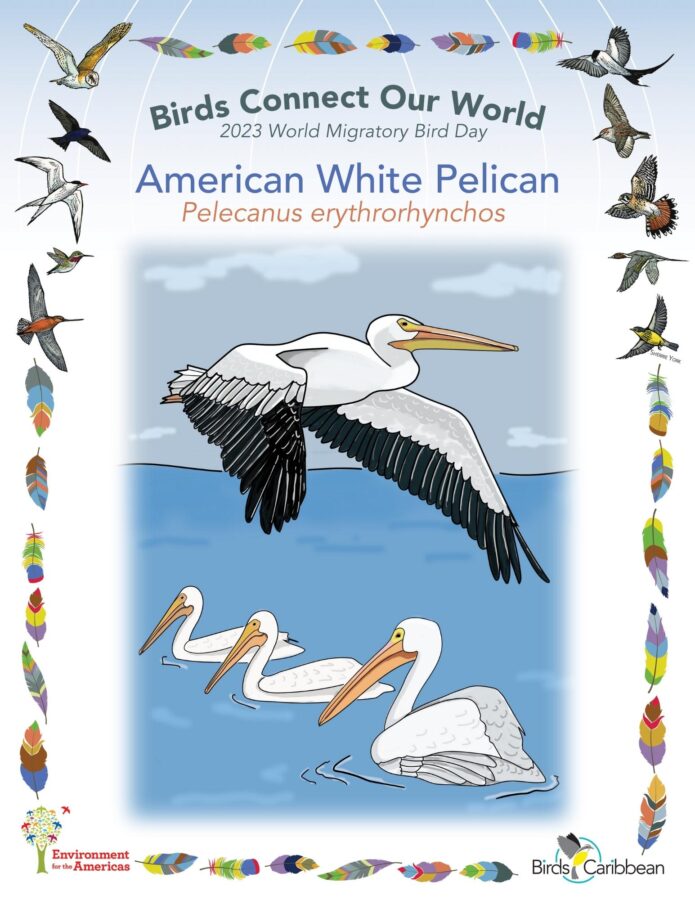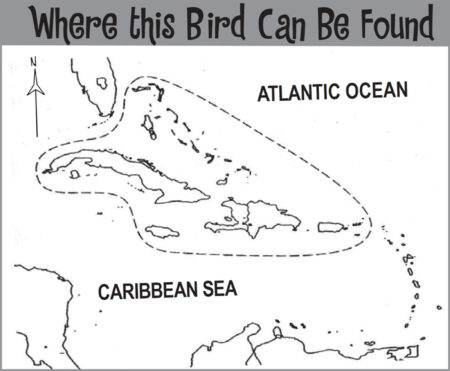Celebrate World Migratory Bird Day (WMBD) with us in 2023! This year’s theme is “Water: Sustaining Bird Life”. Have fun learning about a new migratory bird every day. We have coloring pages, puzzles, activities, and more. Download for free and enjoy nature with your family at home.
Migratory Bird of the Day: American White Pelican
If you look to the sky and spot a flock of large, conspicuously white birds, with black flight feathers, yellow bills and legs, soaring gracefully on broad, stable wings—no doubt, you have found a flock of American White Pelicans! These beautiful birds are easy to identify with their huge size, large pinkish-yellow bill, and white coloration. If the bill is gray instead of yellow, then you have spotted an immature bird in its first year! You will never, however, confuse this bird with its cousin, the Brown Pelican. Whilst they share part of their geographic distribution, and may be found together in wetlands, the Brown Pelican is smaller, with a darker coloration and a completely different feeding behavior.
When feeding, American White Pelicans obtain their food by dipping their bills into the water and scooping up fish, their main prey. This is usually done in very shallow freshwaters, although they will also feed in saline waters. The Brown Pelican feeds on fish as well, however, they plunge-dive from high up in the air, using the force of impact to stun small fish before scooping them up.
If you visit the shallow lagoons that pelicans prefer, you can observe each species feeding in their own way. Brown Pelicans look for food alone, each bird swooping down rapidly to catch their prey. White Pelicans forage cooperatively, using clever group strategies to capture fish. Coordinated flocks of swimming birds work together to encircle fish and herd them into the shallows where they become concentrated and can be more easily caught with synchronized bill dipping. Their enormous bills with elastic, expandable, pouches below then come into play—the pelicans scoop prey again and again into their pouch, an amazing spectacle when hundreds of these birds are feeding together!
This species breeds in western and central North America, laying two white eggs in a nest constructed in the soil. They are attentive caregivers to their young—from the moment the chicks hatch, both parents spend the day looking for fresh food to help them grow. By three weeks of age they are more mobile and parents begin to leave their nests unattended, coming back only to bring food. At this age, the young birds begin to form creches, for protection and warmth.
During autumn the species migrates south, spending the winter in southern California, the Gulf States, Mexico, and Central America. Most literature states that American White Pelicans are vagrant in the West Indies, with very few reports. Some researchers even say that they do not cross oceanic waters, but news flash: this information is no longer accurate! They do cross the Atlantic Ocean and the Gulf and they are now common birds in Cuba! In February 2021, citizen scientists in Cuba recorded 1,700 individuals in one aquaculture farm in the Pinar del Río Province in western Cuba. A resident population of about 300 lives year-round in the wetlands of Los Palacios in the same province, and during winter migration they are common in most Cuban coastal wetlands in the western part of the country, for example, Zapata Swamp. Visit eBird Caribbean to observe all these recent sightings.
Do you want to enjoy majestic flocks of soaring American White Pelicans on a sunny day or watch them while foraging? Join a BirdsCaribbean Birdwatching Tour, and you will surely enjoy the White Pelican on their wintering grounds in the Las Salinas lagoons of Zapata Swamp! Learn more about this species, including its range, photos, and calls here.
Thanks to Lourdes Mugica for the text and Christine Elder for the lovely illustration!
Color in the American White Pelican
Download the Migratory Birds of the Day Coloring Page! Use the picture above and the photos on this page as your guide, or look up pictures of the bird online or in a bird field guide if you have one. Share your colored-in page with us by posting it online and tagging us @BirdsCaribbean #WMBD2023Carib
Listen to the calls of the American White Pelican
Adult American White Pelicans are usually silent, especially when not breeding. At breeding colonies you might hear them give frequent low, brief grunts.
Puzzles of the Day
Click on the images below to do the puzzle. You can make the puzzle as easy or as hard as you like—for example, 6, 8, or 12 pieces for young children, all the way up to 1,024 pieces for those that are up for a challenge!
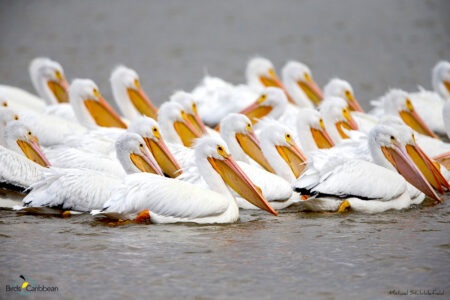
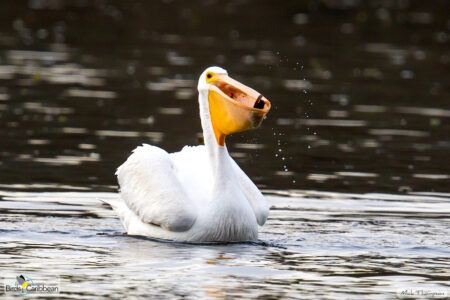
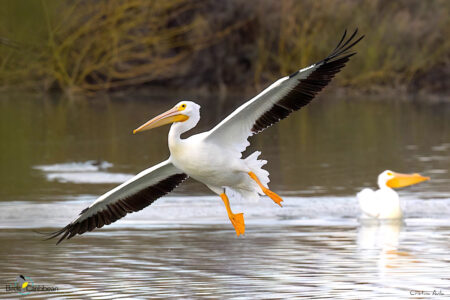
Activity of the Day
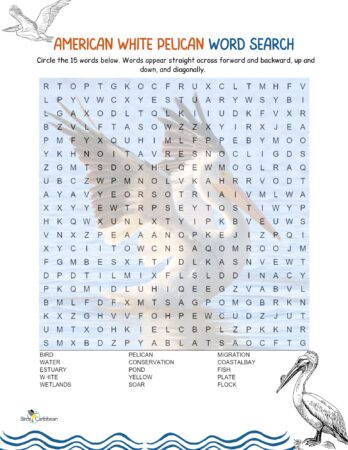 FOR KIDS: Can you find the words in our American White Pelican word search? Remind yourself of some of the interesting facts about this water-loving migratory bird as you look for all 15 hidden words!
FOR KIDS: Can you find the words in our American White Pelican word search? Remind yourself of some of the interesting facts about this water-loving migratory bird as you look for all 15 hidden words!
Remember the words may appear forwards and backwards, as well as horizontal, vertical and diagonal! Need some help? Or want to check your answers? You can see where all the words were here.
FOR KIDS AND ADULTS: Enjoy these videos of American White Pelicans in the wild! In the first video, you can see what this bird looks like when it is flying.
In the second video, you can see a couple of birds in their winter plumage swimming.

